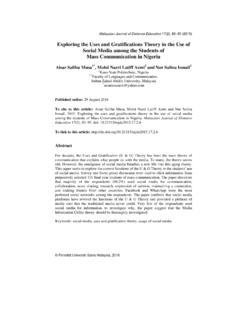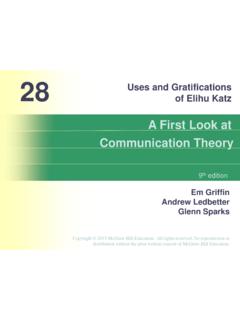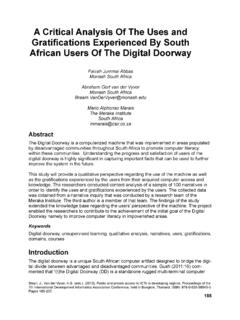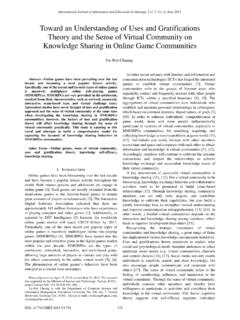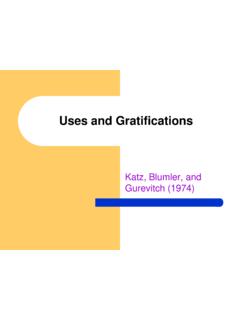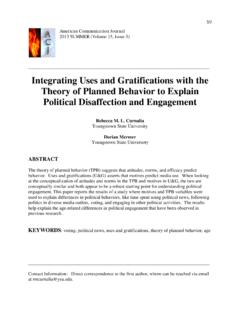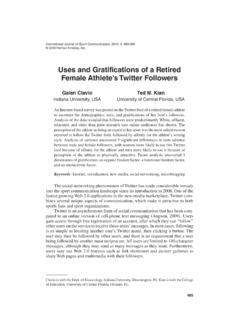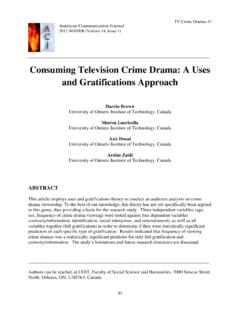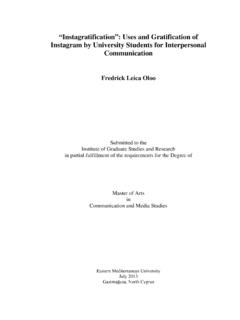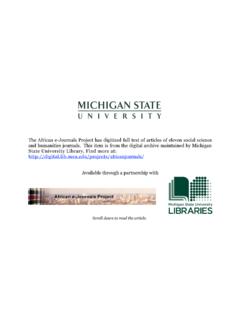Transcription of MOTIVATIONS TO TWEET: A USES AND GRATIFICATIONS ...
1 MOTIVATIONS TO TWEET: A uses AND GRATIFICATIONS PERSPECTIVE. OF TWITTER USE DURING A NATURAL DISASTER. by ELIZABETH MARIE MAXWELL. J. SUZANNE HORSLEY, COMMITTEE CHAIR. WILLIAM J. GONZENBACH. ROSANNA E. GUADAGNO. A THESIS. Submitted in partial fulfillment of the requirements for the degree of Master of Arts in the Department of Advertising and Public Relations in the Graduate School of The University of Alabama TUSCALOOSA, ALABAMA. 2012. Copyright Elizabeth Marie Maxwell 2012. ALL RIGHTS RESERVED. ABSTRACT. On April 27, 2011, Tuscaloosa, Alabama, was struck by an EF-4 tornado. This research investigates how students at The University of Alabama used Twitter during the warning, impact and recovery stages of the disaster.
2 The warning stage refers to the time before the disaster. The impact stage refers to the time during the disaster, and the recovery stage refers to the time after the disaster. Specifically, this research studies four MOTIVATIONS to use Twitter social, entertainment, status seeking, and information. Each category was studied to understand when people who were motivated by the need to socialize, to entertain, to gain status or to gather information were actively tweeting in connection with the tornado. By using a mixed design ANOVA, the researcher found that students were tweeting significantly more during the recovery stage, which included Twitter use, during the weeks after the tornado.
3 The researcher was interested in knowing which motivation produced the most Twitter use. The social, entertainment, and information MOTIVATIONS produced roughly the same amount of Twitter use. The status motivation did not produce as much Twitter use during the natural disaster. The results suggest that those motivated by social, entertainment or information needs tweet more during the impact and recovery stage. The most Twitter use occurs in the weeks after the disaster during the recovery stage. ii LIST OF ABBREVIATIONS AND SYMBOLS. M Mean: the sum of a set of measurements divided by the number of measurements in the set p Probability associated with the occurrence under the null hypothesis of a value as extreme as or more extreme than the observed value Wilks' Wilks' Lambda probability distribution F(x, y) F with x and y degrees of freedom n Number of cases in subsample r Pearson product-moment correlation CI Confidence Interval Grp.
4 Group iii ACKNOWLEDGMENTS. I am happy to have this opportunity to thank the many individuals that helped me form this thesis. This journey would have never been completed without the help of my committee, the Advertising and Public Relations faculty, friends and family. Many thanks go to my committee. Thank you Dr. Gonzenbach and Dr. Guadagno for always having an office door open and giving help when it was asked. Most importantly, I want to thank Dr. Horsley for being my committee chair. Thank you for your invaluable insight and constant encouragement. Without your direction, I probably would still be working on my proposal.
5 I would like to take this opportunity to also thank The University of Alabama's Advertising and Public Relations Department. Throughout my time at the University they have inspired me to be involved and grow as a person. I would have never attempted graduate school or my thesis without their support. I would like to especially thank Mrs. Jade Abernathy and Mrs. Cheryl Parker. Thank you for hiring me so many years ago. Without that opportunity, I don't think I would be where I. am today. Finally, I want to extend my sincerest thanks to my family and friends. Thank you for your support and listening ears.
6 I would also like to thank you for keeping me on track and always holding me accountable for my work ethic. I hope you enjoy your much deserved break from listening to me obsess about Twitter and/or natural disasters. This adventure would never been completed without all of your prayers, guidance, support, and encouragement. I am indebted to you all. Thank you. iv CONTENTS. ABSTRACT ..ii LIST OF ABBREVIATIONS AND SYMBOLS ..iii ACKNOWLEDGMENTS ..iv LIST OF TABLES ..vi 1. INTRODUCTION ..1. 2. LITERATURE REVIEW ..5. 3. theory ..18. 4. METHOD ..27. 5. RESULTS ..32. 6. DISCUSSION ..50. REFERENCES.
7 57. APPENDIX APPENDIX B ..74. v LISTS OF TABLES. 1. Correlations of Information MOTIVATIONS Variables ..35. 2. Pairwise Comparison of Simple Effects for Social Motivation Categories ..38. 3. Pairwise Comparison of Social Motivation Simple Effects for Time ..39. 4. Pairwise Comparison of Motivation Group and Time ..40. 5. Social Motivation Groups' Mean Scores over Three Stages ..41. 6. Pairwise Comparison of Simple Effects for Entertainment Motivation Categories ..42. 7. Pairwise Comparison of Entertainment Motivation Simple Effects for Time ..42. 8. Pairwise Comparison of Motivation Group and Time.
8 43. 9. Entertainment Motivation Groups' Mean Scores over Three Stages ..44. 10. Pairwise Comparison of Simple Effects for Information Motivation Categories ..45. 11. Pairwise Comparison of Information Motivation Simple Effects for Time ..46. 12. Pairwise Comparison of Motivation Group and Time ..47. 13. Information Motivation Groups' Mean Scores over Three Stages ..47. 14. Social Motivated Users Mean Score ..48. 15. Entertainment Motivated Users Mean Score ..49. 16. Information Motivated Users Mean Score ..49. vi Introduction The mundane task of calling home became impossible for many college students on the night of April 27, 2011.
9 Around 5:10 that day, Tuscaloosa, Alabama, was hit by an EF-4. tornado. The tornado was more than a mile wide and created a six-mile path of destruction. The tornado resulted in 53 fatalities and more than 1,200 injured individuals (Morton, 2012). According to Meredith Lynch, public relations coordinator for the City of Tuscaloosa's Incident Command, the storm left 12% of the city in ruin (2011). City buildings were damaged, along with 600 businesses and thousands of residential structures. On that April day, Tuscaloosa became one of the most popular news stories both nationally and internationally.
10 Tuscaloosa, Alabama, is home to the thousands of students who attend the University of Alabama. The destruction left many of the students and citizens of Tuscaloosa unable to use traditional forms of communication to reach loved ones or find information about the recent storm. Cell phone service was nonexistent for many during that time because the city communication towers were destroyed by the fatal storm (Lynch, 2011). The only way many residents communicated their safety to loved ones was through the use of their smart phones' Internet capability. Because of this event, and others like it, the use of social networks during disastrous events has become an emerging field of study.

